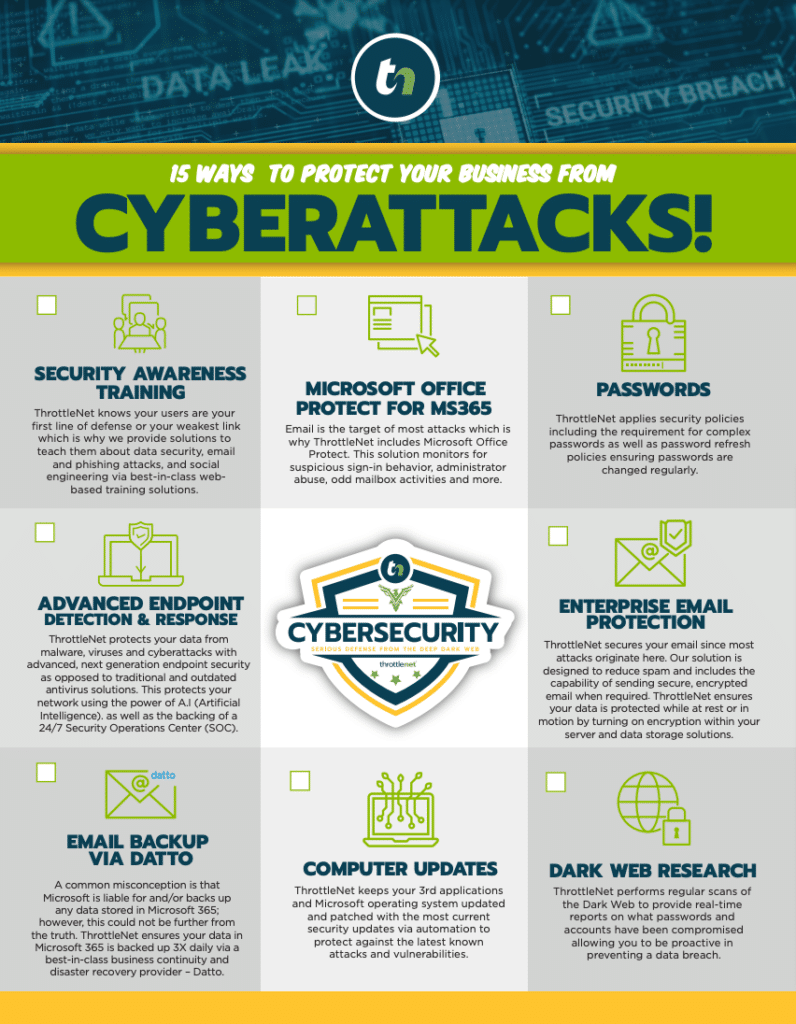
Cybercriminals are evolving faster than ever — and local businesses are squarely in their sights. In today’s digital landscape, having the right cybersecurity strategies is no longer optional; it’s essential for survival.
Across St. Louis and the greater Midwest, small to mid-sized companies are becoming prime targets for ransomware, phishing, and data theft because hackers assume they lack enterprise-level defenses.
At ThrottleNet, we’ve spent over 25 years proving them wrong. Our award-winning managed IT and cybersecurity services protect hundreds of St. Louis businesses with industry-leading response times, advanced security operations, and expert-led strategy. With an average two-minute response time and 93% same-day resolution, we stop threats before they impact your operations.
Here are five proven cybersecurity strategies hackers definitely don’t want you to know.
1. Train Your Employees — Because They’re the Front Line
The strongest firewall in the world can’t stop an employee from clicking a malicious link. Human error remains the #1 cause of data breaches — which is why training is one of the most effective cybersecurity strategies you can invest in.
Why it matters:
Hackers rely on deception, using fake invoices, spoofed emails, and realistic-looking login pages to trick users into handing over credentials or launching malware.
The fix:
ThrottleNet’s cybersecurity awareness training and ongoing phishing simulations help your team identify red flags before they become threats. By turning employees into vigilant defenders, you build a true culture of cybersecurity resilience.
“We teach users to think like hackers — so they can stop attacks before they start,” says ThrottleNet COO Eric Aguado.
2. Patch Early, Patch Often
Cybercriminals love outdated software. Every time a company delays updates, they’re essentially leaving the back door open.
Why it matters:
Studies show that nearly 80% of ransomware attacks exploit known but unpatched vulnerabilities. That means these attacks aren’t “sophisticated” — they’re simply opportunistic.
The fix:
ThrottleNet’s automated patch management ensures every system, app, and device stays updated and protected. Combined with 24/7 monitoring from our Security Operations Center (SOC), your infrastructure is continuously shielded from known exploits.
3. Back Up Smarter, Not Just More Often
Not all data backups are equal — and hackers know it. If your backups are connected to your live network, ransomware can encrypt them too, leaving you without a clean recovery point.
Why it matters:
Traditional backups fail when they’re not isolated or tested regularly, resulting in devastating downtime.
The fix:
ThrottleNet employs redundant, encrypted, and offsite backup solutions that are verified automatically. Our disaster recovery plans ensure business continuity even in the face of a full-scale attack. And with our $500,000 Cybersecurity Protection Guarantee, you gain peace of mind knowing your recovery costs are covered if a breach occurs under our watch.
4. Build Multi-Layered Defense Systems
Hackers don’t rely on a single trick — so your defense can’t rely on a single tool. Multi-layer protection remains one of the most effective cybersecurity strategies for small and mid-sized businesses.
Why it matters:
A basic antivirus program can’t defend against phishing, zero-day exploits, or AI-driven attacks.
The fix:
ThrottleNet deploys a multi-layered defense architecture that includes:
- Next-gen antivirus with AI detection
- Firewall and network security management
- Dark web monitoring for compromised credentials
- Email filtering and backup
- 24/7 persistent threat monitoring
Each layer is managed by specialized engineers — not generalists — to ensure that protection evolves with every new threat.
5. Integrate Cybersecurity Into Business Strategy with a vCIO
The final (and often overlooked) strategy is strategic leadership. Cybersecurity shouldn’t just be an IT issue — it’s a business imperative.
Why it matters:
Many companies react to threats after the fact, rather than planning to prevent them. That reactive approach costs more in downtime, recovery, and lost trust.
The fix:
ThrottleNet assigns every client a dedicated vCIO (Virtual Chief Information Officer) who provides high-level IT leadership and strategic guidance. Your vCIO ensures that cybersecurity, compliance, and technology investments align with your business goals — so your IT strategy always supports growth, not just defense.
“We help businesses make cybersecurity part of their DNA,” says ThrottleNet CEO George Rosenthal. “When security and strategy move together, risk drops dramatically.”

Bonus: Don’t Let Response Time Be Your Weak Link in Your Cybersecurity Strategies
Even the best cybersecurity strategies can fall short if your IT provider is slow to respond. Hackers exploit every minute of delay.
That’s why ThrottleNet leads the Midwest with an average two-minute response time — the fastest in the industry — and 93% same-day resolution. Our rapid-response model minimizes damage, downtime, and data loss before they ever reach your customers.
ThrottleNet: Trusted Cybersecurity Experts Across the Midwest
From St. Louis to Kansas City, ThrottleNet delivers proactive cybersecurity strategies that protect growing businesses across the Midwest. Whether you need fully managed IT support or co-managed cybersecurity, our solutions include:
- 24/7 monitoring from our local Security Operations Center
- AI-driven endpoint protection
- Cybersecurity awareness training
- Automated patch management
- Strategic vCIO guidance
ThrottleNet has been named Best IT Firm in St. Louis by Small Business Monthly for over a decade — because we don’t just fix problems, we prevent them. Our open-book management and customer-first culture empower every team member to deliver results that turn technology frustration into joy.
Final Takeaway
Hackers count on complacency. The longer you delay improving your cybersecurity strategies, the more vulnerable your business becomes. But with a proactive partner like ThrottleNet, you gain 24/7 protection, local expertise, and measurable peace of mind.
Don’t wait for your next IT crisis — protect your business before it happens.
👉 Schedule your free cybersecurity consultation today and see why St. Louis businesses trust ThrottleNet to defend their future.



